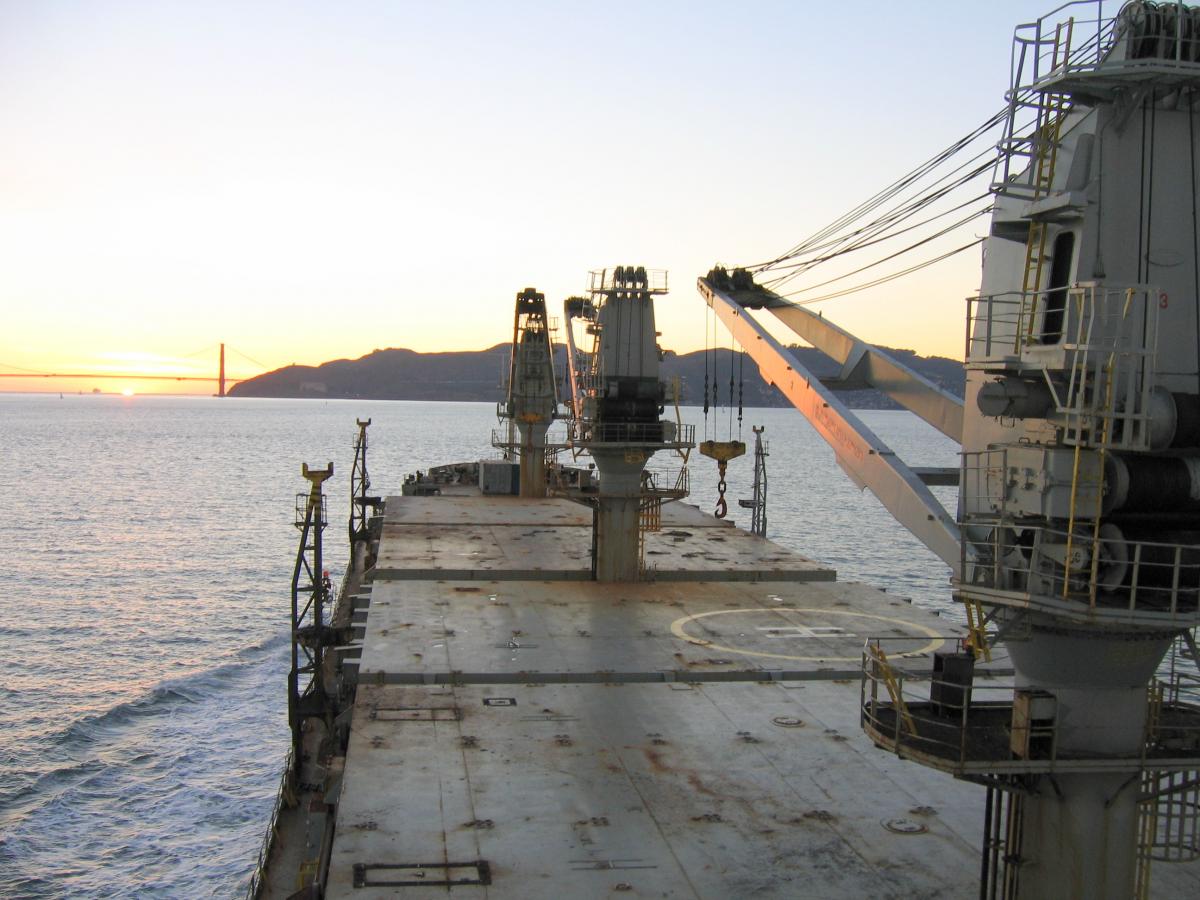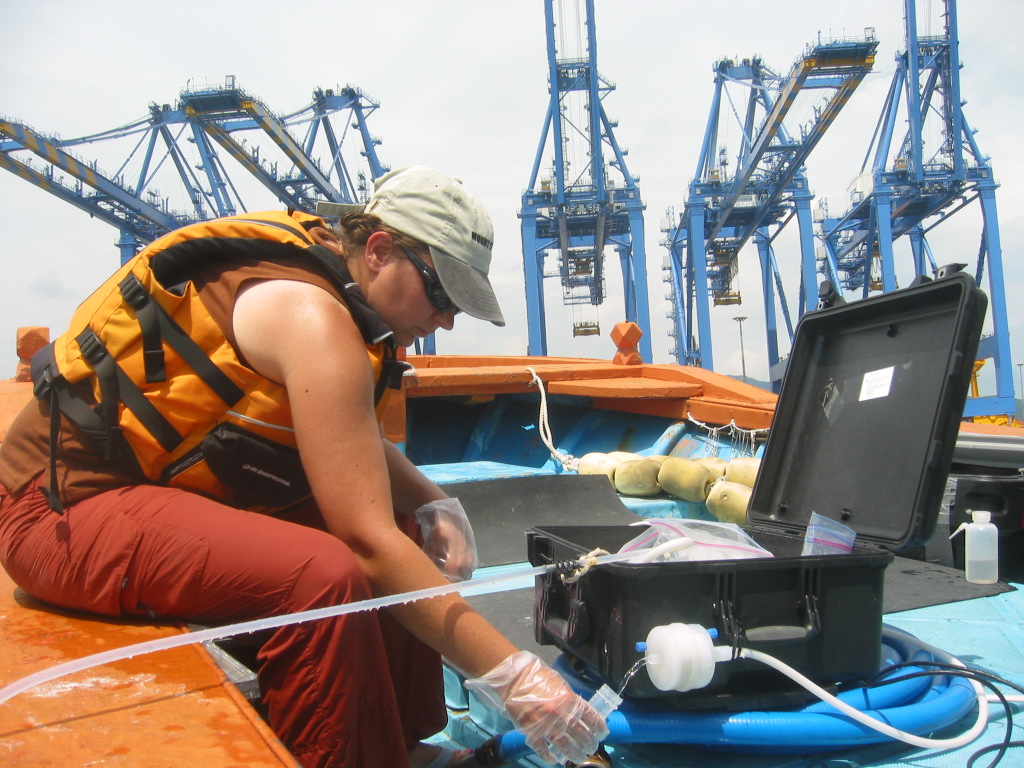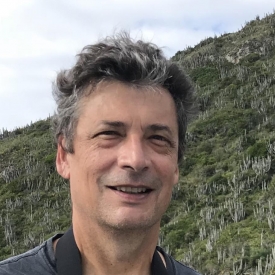
Environmental regulations are informed by science. In the case of introduced marine and freshwater species, it was scientists who first sounded the alarm in the 1980s that non-native organisms were being introduced through the discharge of ballast water. The research that followed found that the likelihood of invasions, and associated ecological and economic impacts, could be reduced if ships’ exchanged their ballast water in the mid-ocean. The United States Coast Guard (USCG) now requires ships to treat their ballast water prior to discharge, using ballast water exchange or other approved treatment technologies. Reliable methods to verify ballast water exchange on arriving vessels were not available when this regulation took effect. To address this, a team of scientists from the Smithsonian Environmental Research Center’s (SERC) Marine Invasions Research Lab set out to answer the following question “Can chemistry tell us where ballast water comes from?”
Background
When commercial ships are not fully loaded with cargo, they can carry large volumes of ballast water to weight and balance the ship during sailing and loading/unloading operations. This water is taken aboard from surrounding coastal and ocean water, and it can contain thousands organisms that are transferred from one port to another. When ships conduct ballast water exchange, they replace the water in the ballast tanks from coastal sources with water from the mid-ocean. Mid-ocean water contains fewer organisms and fewer that can survive outside of the mid-ocean environment, thus lowering the risk of introducing marine species upon discharge into the recipient ports. When properly implemented, ballast water exchange can reduce the risk of species introductions.
The USCG and the Environmental Protection Agency are charged with developing and enforcing ballast water regulations. Federal Regulations require ships traveling to the United States to report how much ballast water they are carrying, where it came from, whether it was exchanged (or treated), and how much they plan to discharge in US waters. For vessels arriving from overseas, and for some coastal routes, regulations require treatment of ballast water prior to discharge, and one approved treatment method is mid-ocean ballast water exchange greater than 200 nautical miles (nmi) from shore.
The Research Question
Is there a quick, simple test that can be used to distinguish mid-ocean from coastal water and verify that a ballast tank has undergone exchange?

The Ballast Water Verification Project began in 2002 to address this question by assessing the potential application of naturally-occurring chemical attributes of seawater to distinguish port water from mid-ocean water. This research was sponsored by USCG, the National Oceanographic and Atmospheric Administration (NOAA), the state of California, and New Zealand. Researchers Dr. Kate Murphy, Dr. Greg Ruiz, Dr. Jennifer Boehme and a team of scientists measured many components of seawater in multiple oceans and along different continents, including salinity, dissolved organic matter, trace elements such as barium, phosphorus and manganese, and radium isotopes.
After several years and numerous voyages across the oceans on commercial vessels, they determined that dissolved organic matter was the most reliable tracer for determining port water from ocean water in ballast tanks. The amount of organic matter from terrestrial sources dissolved in seawater decreases with increasing distance from shore. The amount of this organic matter in seawater is inferred by measuring the fluorescence intensity of the water using light. By measuring the dissolved organic matter fluorescence (fDOM) along offshore transects and in numerous ballast tanks, they located a fluorescence threshold that appeared to distinguish ocean water from port water.
In order for fluorescence to be a reliable test of ballast water exchange, the scientists wanted to know if fluorescence in port water (or unexchanged ballast water) is higher than threshold levels in every port and all times of the year. Are there any ports where fluorescence is as low as in the mid-ocean? To answer these questions, a large team of researchers performed extensive surveys of the eastern North Pacific Ocean.
In their 2012 paper in the Journal of Marine Systems, Dr. Murphy and coauthors presented fluorescence data from over 2000 sites in ports, coastal waters, and oceanic waters along the West Coast of the US from Southern California to Alaska. They found that fDOM could reliably distinguish between water from very close to shore (0.2 nmi), from ocean water greater than 100nmi from shore. But between these two zones there were some coastal areas that had either very low fDOM or very high fDOM. For example, some coastal areas between 0.2 and 25nmi had very low fluorescence similar to ocean water and some areas between 25 and 100nmi had very high fluorescence similar to port water.
The Application of Scientific Research in Policy
With a tool to distinguish ballast water exchanged in the mid-ocean from unexchanged port water, some ships that have failed to exchange their coastal ballast could be easily identified. While scientists have been able to inform policy makers about potential solutions and pitfalls related to this problem, the challenge for policy makers and resource managers is to integrate science with practical constraints, such as cost, feasibility, and scale of implementation.
Further Reading
Murphy, Kathleen R., Boehme, Jennifer, Cobel, Paula, Cullen, Jay, Field, Paul, Moore, Willard, Perry, Elgin, Sherrell, Robert and Ruiz, Gregory M. 2004. Verification of mid-ocean ballast water exchange using naturally occurring coastal tracersi. Marine pollution bulletin, 48: 711-730.
Murphy, I., Ruiz, Gregory M., Dunsmuir, W. T. M. and Waite, T. D. 2006. Optimized parameters for fluorescence-based verification of ballast water exchange by ships. Environmental Science & Technology, 40(7): 2357-2362.
Murphy, Kathleen R., Field, M. P., Waite, T. D. and Ruiz, Gregory M. 2008. Trace elements in ships' ballast water as tracers of mid-ocean exchange. Science of the Total Environment, 393(1): 11-26.
Murphy, Kathleen R., Boehme, Jennifer R., Noble, Monaca, Smith, George E. and Ruiz, Gregory M. 2009. Deducing ballast water sources in ships arriving in New Zealand from southeastern Australia. Marine Ecology Progress Series, 390: 39-53. doi:10.3354/meps08178
Murphy, Kathleen R., Boehme, Jennifer R., Brown, Christopher, Noble, Monaca, Smith, George, Sparks, Darrick and Ruiz, Gregory M. 2012. Exploring the limits of dissolved organic matter fluorescence for determining seawater sources and ballast water exchange on the US Pacific coast. Journal of Marine Systems, doi:10.1016/j.jmarsys.2012.10.010


